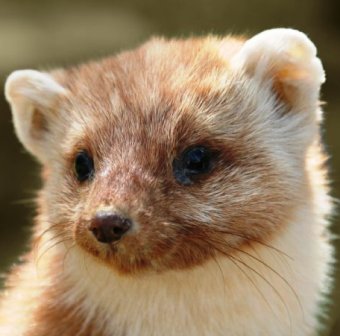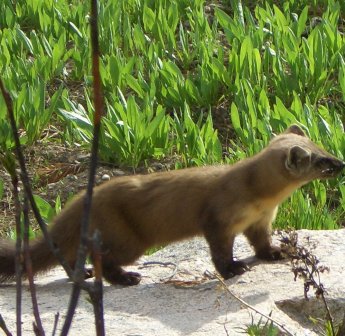The Pacific marten (Martes caurina) is a
carnivorous furbearing member of the weasel family. The
marten's coat is characterized by soft, dense fur which
varies in color from pale yellow to dark brown, often
shading to black on the feet and legs. The Pacific
marten on Admiralty Island tend to be yellowish orange
in color. Lighter-colored martens tend to have grayish
brown tails, while darker animals have dark brown tail
fur. The fur around the muzzle varies from gray to light
brown with a short dark line extending up the forehead
from the corner of each eye. The marten's throat and
upper chest are usually pale or buff or deep orange. The
ears are erect and rounded giving martens and almost cat
like appearance. Martens vary in body length from 19 to
25 inches (48-65 cm), not including the tail. They may
weigh up to nearly 4 pounds (1.8 kg). Males are
considerably larger than females. The tail accounts for
nearly a third of the marten's total length. Martens
have sharp, non-retractable claws which they use for
climbing as well as for holding their prey. Large furry
paws allow the marten to travel easily over deep snow.
Martens depend heavily on meadow voles and red-backed
voles or mice, which are their primary food source over
much of Alaska. Fluctuations in food availability often
create corresponding variations in marten populations.
This condition is more pronounced in the less optimum
habitat of the marten. Probably the second most critical
food source is berries, especially blueberries, followed
by small birds, eggs, and vegetation. Marten will also
eat squirrels and if food is scarce enough will
occasionally exhibit cannibalism. The marten is a
voracious and opportunistic feeder. Carrion such as the
remains of wolf kills; salmon carcasses or winter killed
ungulates are eaten in many areas. Wild martens are fond
of sweets such as jam. They will sometimes take treats
from humans. Although martens are suited for nocturnal
foraging, they are also active during mornings and
evenings, especially during the long days of summer.
The Pacific marten is found only in the western US and the Pacific coastal islands of Vancouver, Queen Charlotte, Admiralty, and Kuiu. Within Alaska, there are two known island populations where the Pacific marten occurs. One is found on Kuiu Island and the other on Admiralty Island. Kuiu Island’s population is unique because this is currently the only known island in Alaska were populations of both the Pacific marten and American marten are hybridizing. Like the American marten the Pacific marten is found in forested habitats. It is most often associated with mature and old-growth evergreen forests.
Martens are rather solitary creatures except during the mating season. Mating encounters are temporary and males may mate with multiple females which live within their home ranges. Mating occurs in July and August. Fertilization is followed by a period of delayed implantation, during which the fertilized eggs do not develop beyond the multi-cellular blastocyst stage. After six months the blastocysts implant in the uterus and embryos begin to develop, growing rapidly for about 27 days. The litter, averaging three young, is born in April or May. Young martens are highly dependent at birth and weigh only about 1 ounce (28 gm). Sparsely covered with fine hair, their eyes do not open until they are 5 to 6 weeks of age. Under their mother’s care, young martens grow rapidly. By late summer they can forage for themselves and become independent. Juvenile martens usually disperse from their mother’s territory during the autumn. Martens normally mate for the first time when they are 2 years old and bear young in their third year. Some females may breed at 15 months. Males typically have larger home ranges than females. Within sexes, home ranges are exclusive with little overlap. Home ranges of martens vary in size in response to population levels and food availability. Although 1 square mile may be sufficient for a male when food is abundant; 15 square miles may be required when food is scarce. When food is in very short supply, martens may leave their regular home range areas entirely and travel extensively to find food. Young begin to disperse in late summer, looking for vacant space to establish a home range. While hunting for food, martens cross their home range areas frequently seeking areas with small mammals and resting sites. In Southeast Alaska, martens select cavities in large, old-growth trees for den sites and resting.
|








